Table of contents
Curry leaves are a popular spice for preparing Asian dishes. It is important to ensure that they are organic, as commercially grown leaves are often contaminated. They can be used raw, but are usually cooked in stews (curries).
Use in the kitchen
Curry leaves are leaves of the Asian curry tree ( Murraya koenigii). This should not be confused with the Mediterranean curry herb (Italian strawflower, Helichrysum italicum). The latter smells of the well-known curry powder. Indian curry leaves, on the other hand, have a fresh, slightly fruity to smoky taste and smell of citrus fruits. Since drying significantly reduces aroma and taste, organic curry leaves are best used fresh.
Can you eat curry leaves? Curry leaves are edible because they are thin. You don't have to remove them after cooking like you would with bay leaves.
They are used in Sri Lankan and South Indian cuisine to season mainly vegetarian and vegan dishes. They go well with most vegetables, potatoes, lentils and chickpeas. Curry leaves are combined with chili peppers and black mustard seeds to make red lentils or moong daal (dal). They also taste good with tamarind and in coconut milk.
A few leaves are enough to flavor a sauce or a dish. To release their full flavor, the leaves need to be heated. You can either roast them in oil or ghee (clarified butter) over a medium heat, or you can add the whole or chopped leaves to the dish about 15 minutes before the end of the cooking time, which is much healthier.
If you have fresh, organic curry leaves, you can freeze them to preserve the flavor. Because of the loss of flavor during drying, you will need to use at least double the amount of dried leaves.
In India you can buy curry leaf powder. This is not to be confused with curry powder, a spice mixture. Curry leaf powder has a less intense taste than fresh leaves, but it lasts longer and is easy to dose. In addition to the spice powder, food supplements based on curry leaves are also sold.
Vegan recipe for Indian potatoes with curry leaves
Ingredients (for 4 people): 1 kg potatoes (waxy), 3 tsp curry powder, 1 tsp turmeric, 4 spring onions, 3 tbsp rapeseed oil, 15 curry leaves, 1 cinnamon stick, 1 tsp brown mustard seeds, 1 tsp cumin seeds, 1 lemon (organic), salt,black pepper.
Preparation: Wash the potatoes thoroughly and cook in their skins until almost cooked, drain and peel. After cooling, cut the potatoes into wedges. Mix the potatoes with curry powder, chili powder, turmeric and salt. Wash and clean the spring onions and cut into 1 cm wide pieces. Heat the rapeseed oil in a large pan and fry the potatoes. Reduce the heat and add the curry leaves, cinnamon, mustard seeds and cumin to the potatoes. Fry for 1 minute. Stir in the spring onions and fry for a further 4 minutes. Squeeze the lemon. Season the potatoes with lemon juice, salt and pepper.
Making tea with curry leaves
You can also make tea with fresh or dried curry leaves (organic). To do this, boil 8-10 curry leaves (raw) with 2-3 cups of water in a pot for around 15-20 minutes. Turn off the heat and let it steep for 10 minutes. Filter the tea with a sieve and season with honey and a little lemon juice if necessary.
Vegan recipes with curry leaves (raw) can be found under the note: " Recipes that have the most of this ingredient ".
| Not only vegans or vegetarians should read this: Vegans often eat unhealthily. Avoidable nutritional errors. |
Purchasing - Storage
You cannot buy fresh curry leaves (raw) from major retailers such as Coop, Migros, Denner, Volg, Spar, Aldi, Lidl, Rewe, Edeka, Hofer, Billa. You cannot find fresh curry leaves in organic supermarkets such as Denn's Biomarkt and Alnatura either. Fresh and dried curry leaves can be found in Asian shops and in herb and spice shops. Dried curry leaves can also be ordered from online shops. It is important that you buy organically grown products that have a tested seal of quality (see Dangers).
Curry leaves should not be confused with curry powder or curry herb (Italian strawflower, Helichrysum italicum).
The availability of curry leaves (raw) varies depending on the size of the store, catchment area, etc. You can find our recorded food prices for the DA-CH countries above under the ingredient image - and by clicking you can see their development at various suppliers.
Storage tips
Fresh curry leaves can be kept in the fridge for a few days. You can also freeze them and have almost fresh leaves for a few months. Dried curry leaves should be stored like spices in a sealed container in a dark, cool place, protected from moisture.
Ingredients - Nutritional values - Calories
Here we realistically show you the ingredients of spices and herbs per 1 g (instead of per 100 g as usual).
A curry leaf weighs an average of 0.13 g. Usually 8-10 leaves are used per dish. 1 g of curry leaves contain very few calories at just 1.11 kcal. They mainly contain carbohydrates (0.25 g/1g) and proteins (0.06 g/1g) and are practically fat-free. 1
Calcium, vitamin A and iron are the most important essential nutrients that curry leaves offer. However, because of the small amount consumed, they and the macronutrients do not contribute significantly to meeting the respective daily requirement. The secondary plant substances in this ingredient are far more important for the health value. Since all herbs have many health-promoting ingredients, we deliberately avoid the term superfood here. 1
The complete ingredients of curry leaves (raw), the coverage of the daily requirement and comparison values with other ingredients can be found in our nutrient tables. In the article Nutrients explained you will get a detailed insight into the topic.
Health effects
Are curry leaves healthy? Curry leaves contain secondary plant substances that have health-promoting effects. However, since all vegetables, fruits, herbs and spices contain such bioactive substances, in different compositions and contents, the health value of curry leaves should not be overestimated.
Curry leaves are rich in carbazole alkaloids, which are antioxidants and may help against ulcers, cancer and diabetes. 6 They also contain terpenoids, flavonoids, phenolic compounds and essential oils. 3
Curry leaf extracts have anti-inflammatory and antioxidant effects. They act against free radicals that cause oxidative stress in the metabolism. Natural antioxidants from plant sources are considered a promising means of preventing and treating numerous diseases, especially neurodegenerative diseases, cardiovascular diseases and cancer. 3 Ethanol-water extracts at 25 °C have the highest antioxidant activity. The second highest content was found in water extracts at 25 °C. In general, extracts prepared at boiling temperature had a lower antioxidant content than those prepared at room temperature. 9
Curry tree essential oil, usually extracted from the leaves or fruits, is used in cosmetic products, aromatherapy and as a food preservative. 6
Curry leaf powder can be added to foods to increase their nutritional value. For example, in baked goods (biscuits) you can replace up to 10% of the wheat flour with curry leaf powder. This increases the content of proteins, fiber, minerals, β-carotene and radical scavenging activity (RSA) in the finished product. 10
Curry leaves have an antifungal effect due to the essential oil they contain and are effective against a wide range of pathogenic fungi. This explains the use of curry leaves to treat diarrhea, dysentery and skin rashes in traditional folk medicine. 3
Dangers - Intolerances - Side effects
Curry leaves should be rinsed very well and preferably cooked. Commercial products can be contaminated with pesticides and bacteria ( Salmonella, E. coli). 4 Therefore, you should definitely buy organic quality and look for official organic labels and codes from the inspection bodies.
The fresh leaves can be contaminated with insects that can attack and destroy citrus trees. For this reason, direct import by tourists is not allowed in some countries (including the USA). 5
Folk medicine - natural medicine
In Indian folk medicine, the leaves, bark, roots and fruits of the curry tree are used. Curry leaves are traditionally used against vomiting, stomach upsets and indigestion, as well as as a hair tonic and to improve rough skin. When applied externally, they are said to have a cooling and calming effect. The leaves are also said to have a lightening effect on the skin. 2 The various parts of the curry tree are also used to treat diabetes, intestinal inflammation, diarrhea and fever. 3
Ecological footprint - animal welfare
The ecological footprint of a food depends on various factors. The type of agricultural production (conventional vs. organic), seasonal, regional or domestic production or import by truck, ship or plane, different types of packaging and whether the goods are fresh or frozen all play a decisive role. 7
Despite extensive research, we were unable to find any precise information on the carbon footprint of curry leaves. However, the carbon emissions should not be underestimated, as curry leaves usually have to be transported several thousand kilometers before they can be bought in stores.
The curry tree is a drought-tolerant plant, so it grows under natural conditions without artificial water supply. Irrigation is often necessary for commercial cultivation. In general, the water footprint of spices is around 7000 l/kg. In comparison, vegetables have 300 l/kg and grains 1600 l/kg. 11
There are initiatives and labels for spices such as SSI (sustainable spices initiative) or NSSP (National Sustainable Spice Program), which promise certain sustainability standards. But Rainforest Alliance and UEBT ( Union for Ethical Biotrade) also have programs that bring the cultivation of herbs and spices onto a sustainable track through certain supply chain management and certification systems. In addition to preserving biodiversity in the countries where the spices are grown, workers' rights are also secured. Standards for farms and supply chains should take into account the sustainable aspects of production and trade. However, the extent of implementation varies greatly from organization to organization. 12
In conventional agriculture , synthetic herbicides and pesticides are used to protect against unwanted plants and insects. However, these are not only proven to harm the environment, but can also have direct negative effects on people. Often, residues of the pesticides used during cultivation can be found in the end product, which was also found in curry leaves. Ideally, you should buy curry leaves from organic farming.
Worldwide occurrence - cultivation
The curry tree is originally from the Indian subcontinent (including Sri Lanka and Bangladesh). 2,6 The distribution area includes tropical and subtropical countries in Southeast Asia (Thailand, Vietnam, Malaysia, India, China), but also in South Africa and Australia. 2,3,6
In India, curry trees grow wild and in private forest and home gardens. They were grown for home use and the local market. Due to the increasing export potential to the Gulf States and the EU, commercial cultivation is now taking place in several districts of South India. 6
India is the largest producer and consumer of curry leaves. However, there are no official figures on trade volume.
Cultivation - Harvest
Curry trees can also be planted in pots outside of subtropical and tropical regions. However, the frost-sensitive tree must overwinter indoors. The tree is propagated using young plants or you can grow the tree from seeds. Curry trees prefer rich, well-drained soil and a sunny location. 8
Further information
The curry tree ( Murraya koenigii, Syn. Bergera koenigii) is a tree within the rue family (Rutaceae).
Alternative names
The English name is curry leaves (curry leaf).
Bibliography - 12 Sources (Link to the evidence)
| 1. | Joseph S, Peter KV, Curry Leaf (Murraya koenigii), Perennial, Nutritious, Leafy Vegetable. Economic Botany, Jan.-Mar. 1985;39(1):68-73. |
| 2. | Gahlawat DK, Jakhar S, Dahiya P, Murraya koenigii (L.) Spreng: an ethnobotanical, phytochemical and pharmacological review. Journal of Pharmacognosy and Phytochemistry, 2014;3(3):109-119. |
| 3. | Balakrishnan R, Vijayraja D, Jo SH, Ganesan P, Su-Kim I, Choi DK. Medicinal Profile, Phytochemistry, and Pharmacological Activities of Murraya koenigii and its Primary Bioactive Compounds. Antioxidants (Basel). 2020 Jan 24;9(2):101. |
| 4. | Willis C, Sadler-Reeves L, Elviss N, Aird H, Fox A, Kaye M, de Pinna E, Lane C, McLauchlin J. An assessment of the microbiological safety of fresh whole-leaf herbs from retail premises in the United Kingdom with a focus on Salmonella spp. J Appl Microbiol. 2015 Sep;119(3):827-33. |
| 5. | U.S. Customs and Border Protection. Pests found in luggage do not curry favor. 2021. |
| 6. | Raghu BR, Diversity and Distribution of Curry Leaf in India. Journal of Horticultural Sciences, Juliy 2020;15(1):1-8. |
| 7. | Reinhardt G, Gärtner S, Wagner T. Ökologische Fussabdrücke von Lebensmitteln und Gerichten in Deutschland. Institut für Energie - und Umweltforschung Heidelberg. 2020. |
| 8. | Univeristy of Illinois at Chicago (UIC) Heritage Garden. |
| 9. | Sasidharan I, Menon AN, Effects of temperature and solvent on antioxidant properties of curry leaf (Murraya koenigii L.). J Food Sci Technol. 2011;48:366-370.
|
| 10. | Drisya CR, Swetha BG, Velu V et al. Effect of dried Murraya koenigii leaves on nutritional, textural and organoleptic characeteristics of cookies. J Food Sci Technol 2015;52:500-506. |
| 11. | Mekonnen MM, Hoekstra AY. The green, blue and grey water footprint of crops and derived crop products. Hydrol. Earth Syst. Sci. 2011; 15: 1577-1600. |
| 12. | Wenzig J. Nachhaltigkeitsclusterung von Gewürzen. Forschungsprojekt. ZNU Zentrum für Nachhaltige Unternehmungsführung. 2023. |

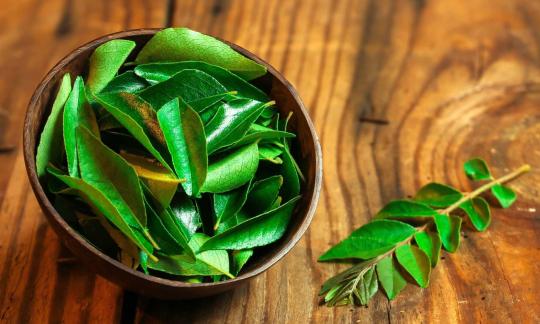

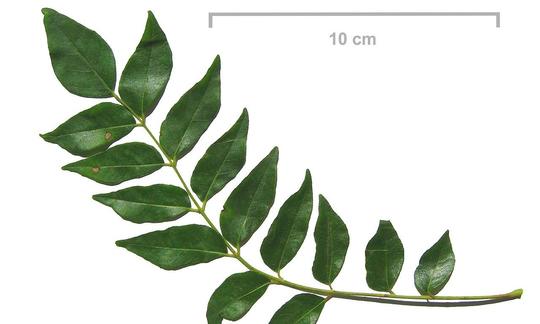

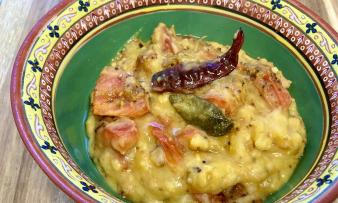
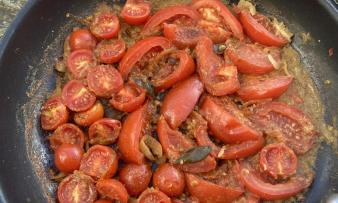
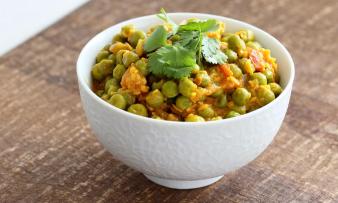





Comments